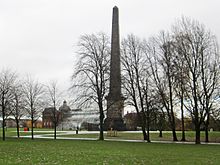Nelson Monument, Glasgow

The Nelson Monument located within Glasgow Green (a historic public park in Glasgow, Scotland) is a commemorative obelisk built in honour of Vice Admiral Horatio Nelson, who had died at the Battle of Trafalgar on 21 October 1805. Funds of £2,075 were raised by subscription, and the foundation stone of the monument was laid with full ceremony on 1 August 1806,[1] on the anniversary of the battle of Aboukir.[2] The monument was finished on 7 August 1807, believed to be the first completed in the UK. It was decorated with four flags, a large crowd watched, and ships at the Broomielaw had their flags hoisted all day. A decision had not then been made on intended inscriptions.[3][4]
The obelisk was designed by the architect David Hamilton.[5] The monument stands 144 feet (44 m) tall, and is enclosed by cast iron railings.[5] There are inscriptions on the four sides of its square plinth; one names him as Horatio, Viscount Nelson, and gives the dates of his birth and death, the other three give the name and date of the battles of Aboukir, Copenhagen, and Trafalgar.[6]
The monument has been described as the first in the UK to celebrate Nelson's victory at Trafalgar.[7] A plaque in front of the column says it was the first civic monument in Britain to Nelson's victories, funded by a public subscription. The monument was constructed by the mason A. Brockett.[8]

Soon after its construction, the obelisk was struck by lightning, leaving a long structural crack in the monument: this event was depicted in a painting by John Knox, which is now in the nearby People's Palace museum. In 1965 a tablet was added to the plinth commemorating James Watt's use of Glasgow Green while thinking about an improved steam engine.[5]
The monument became a category A listed building in 1970.[9]
References

- ^ Scots Magazine, and Edinburgh Literary Miscellany. Sands, Brymer, Murray and Cochran. 1806. p. 641. Retrieved 8 October 2023.
- ^ The Picture of Glasgow, or Strangers' Guide. 1812. p. 132. Retrieved 8 October 2023.
- ^ Hinton, J. (1807). The Universal Magazine of Knowledge and Pleasure. J. Hinton. p. 373. Retrieved 8 October 2023.
- ^ The Scots Magazine and Edinburgh Literary Miscellany. Archibald Constable & Company. 1807. p. 716. Retrieved 9 October 2023.
We believe Glasgow is the first city in the Kingdom , which has completed a monument to the memory of Lord Nelson.
- ^ a b c "Glasgow Green, Nelson Monument, including Railings". Historic Environment Scotland Portal. 1 October 2015. Retrieved 22 November 2016.
- ^ Glasgow Delineated: In Its Institutions, Manufactures, and Commerce: with a Map of the City, and Thirty-nine Engravings of Its Principal Public Buildings. Wardlaw & Cunninghame. 1826. p. 244. Retrieved 8 October 2023.
- ^ Adams, G. (2014). Glasgow's East End Through Time. Amberley Publishing. p. 62. ISBN 978-1-4456-3854-6. Retrieved 10 October 2023.
A predominant feature of the Low Green is Nelson's Monument, erected in 1806; the first in the United Kingdom to celebrate Nelson's historic victory at Trafalgar.
- ^ Photograph of plaque at the foot of the column
- ^ "Glasgow Green, Nelson Monument - British Listed Buildings". www.britishlistedbuildings.co.uk. Retrieved 18 December 2016.
55°51′05″N 4°14′26″W / 55.85150°N 4.24068°W / 55.85150; -4.24068
- v
- t
- e












